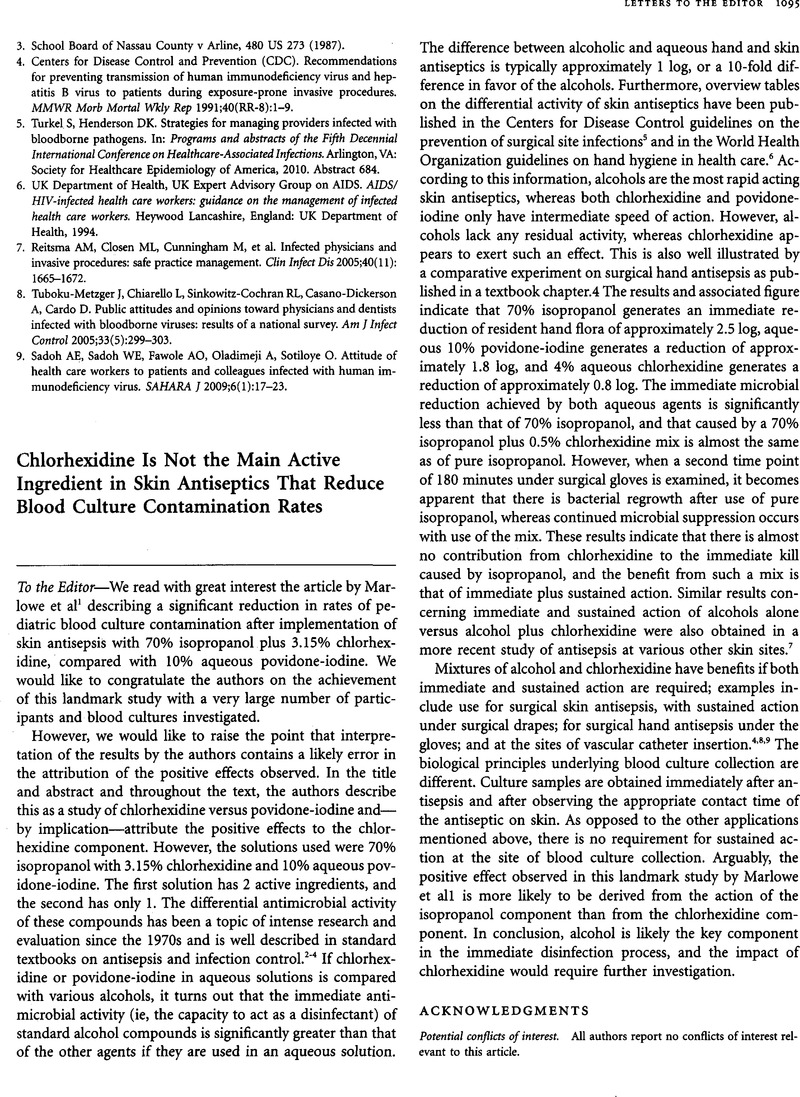Crossref Citations
This article has been cited by the following publications. This list is generated based on data provided by Crossref.
Mistry, Rakesh D.
Marlowe, Lauren
and
Zaoutis, Theoklis E.
2010.
Reply to Maiwald et al.
Infection Control & Hospital Epidemiology,
Vol. 31,
Issue. 10,
p.
1096.
Maiwald, Matthias
Widmer, Andreas F.
and
Rotter, Manfred L.
2011.
Lack of Evidence for Attributing Chlorhexidine as the Main Active Ingredient in Skin Antiseptics Preventing Surgical Site Infections.
Infection Control & Hospital Epidemiology,
Vol. 32,
Issue. 4,
p.
404.
Caldeira, D.
David, C.
and
Sampaio, C.
2011.
Skin antiseptics in venous puncture-site disinfection for prevention of blood culture contamination: systematic review with meta-analysis.
Journal of Hospital Infection,
Vol. 77,
Issue. 3,
p.
223.
Washer, Laraine L.
Chenoweth, Carol
Kim, Hae-Won
Rogers, Mary A. M.
Malani, Anurag N.
Riddell, James
Kuhn, Latoya
Noeyack, Bernard
Neusius, Harry
Newton, Duane W.
Saint, Sanjay
and
Flanders, Scott A.
2013.
Blood Culture Contamination A Randomized Trial Evaluating the Comparative Effectiveness of 3 Skin Antiseptic Interventions.
Infection Control & Hospital Epidemiology,
Vol. 34,
Issue. 1,
p.
15.
Maki, Dennis G
2014.
Chlorhexidine's role in skin antisepsis: questioning the evidence–Author's reply.
The Lancet,
Vol. 384,
Issue. 9951,
p.
1345.
Charehbili, Ayoub
Swijnenburg, Rutger-Jan
van de Velde, Cornelis
van den Bremer, Jephta
and
van Gijn, Willem
2014.
A Retrospective Analysis of Surgical Site Infections after Chlorhexidine–Alcohol versus Iodine–Alcohol for Pre-Operative Antisepsis.
Surgical Infections,
Vol. 15,
Issue. 3,
p.
310.
Hannan, Margaret M.
O'Sullivan, Katie E.
Higgins, Ann M.
Murphy, Ann-Marie
McCarthy, James
Ryan, Edmund
and
Hurley, John P.
2015.
The Combined Impact of Surgical Team Education and Chlorhexidine 2% Alcohol on the Reduction of Surgical Site Infection following Cardiac Surgery.
Surgical Infections,
Vol. 16,
Issue. 6,
p.
799.
Liu, Wenjie
Duan, Yuchen
Cui, Wenyao
Li, Li
Wang, Xia
Dai, Heling
You, Chao
and
Chen, Maojun
2016.
Skin antiseptics in venous puncture site disinfection for preventing blood culture contamination: A Bayesian network meta-analysis of randomized controlled trials.
International Journal of Nursing Studies,
Vol. 59,
Issue. ,
p.
156.
2017.
Prävention von Infektionen, die von Gefäßkathetern ausgehen.
Bundesgesundheitsblatt - Gesundheitsforschung - Gesundheitsschutz,
Vol. 60,
Issue. 2,
p.
216.



